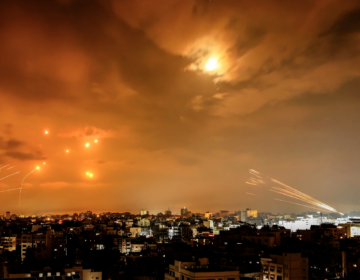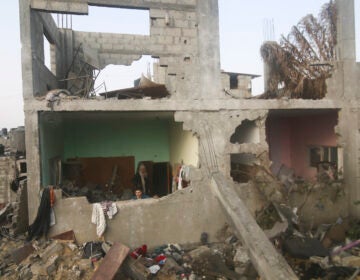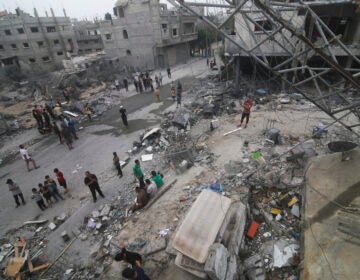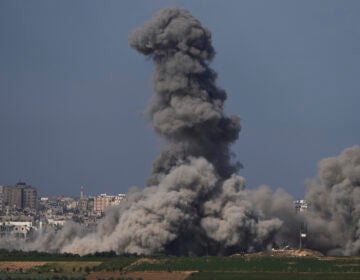Gaza’s doctors struggle to save hospital blast survivors as Middle East rage grows
Aid workers warn the situation is growing perilous. “It’s not just that people are going hungry, people are at the risk of starvation."
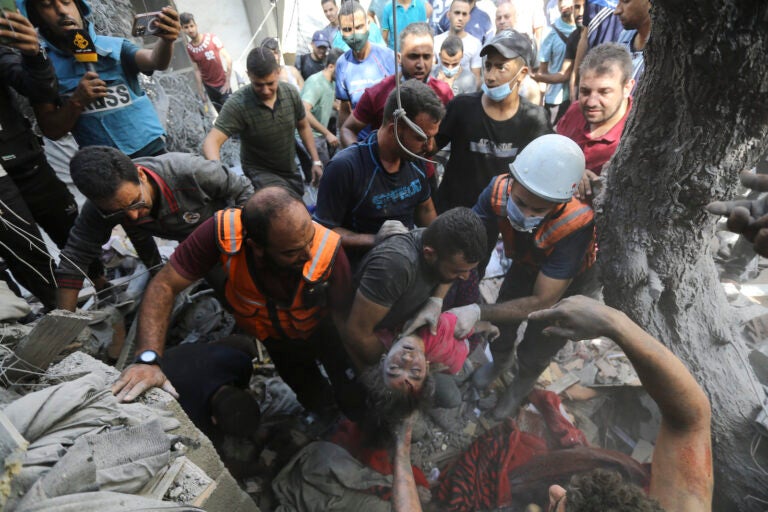
Palestinians rescue a child from under the rubble after Israeli airstrikes in Gaza City, Gaza Strip, Wednesday, Oct. 17, 2023. (AP Photo/Abed Khaled)
What you need to know
- The war between Israel and Hamas has claimed at least 4,200 lives, and is expected to escalate.
- Over 1 million Palestinians have fled their homes in a little over a week, as Israel prepares for an expected ground invasion of Gaza.
- President Biden and Philly-area leaders have largely stood behind Israel.
- Here’s why Hamas and Israel reached this moment now — and what comes next.
Doctors in Gaza City faced with dwindling medical supplies performed surgery on hospital floors, often without anesthesia, in a desperate bid to save badly wounded victims of a massive blast that killed civilians sheltering in a nearby hospital amid Israeli bombings and a blockade of the territory.
The Hamas militant group blamed the blast on an Israeli airstrike, while the Israeli military blamed a rocket misfired by other Palestinian militants. At least 500 people were killed, the Hamas-run Health Ministry said.
Rage at the hospital carnage spread through the Middle East as U.S. President Joe Biden landed in Israel in hopes of stopping a spread of the war, which started after Hamas militants attacked towns and cities across southern Israel Oct. 7.
Biden embraced Israeli Prime Minister Benjamin Netanyahu on his arrival and later said the blast appeared not to be Israel’s fault. “Based on what I’ve seen, it appears as though it was done by the other team, not you,” he told Netanyahu in remarks in front of the media.
Shortly before Biden’s arrival, Palestinian rocket attacks on Israel resumed after a 12-hour lull. Israeli strikes on Gaza also continued on Wednesday, including on cities in south Gaza that Israel had described as “safe zones” for Palestinian civilians.
After the hospital blast, Jordan canceled a meeting between Biden, Jordan’s King Abdullah II, Palestinian President Mahmoud Abbas and Egyptian President Abdel Fattah el-Sissi. Biden will now visit only Israel, a White House official said.
The war between Israel and Hamas was “pushing the region to the brink,” Jordanian Foreign Minister Ayman Safadi told state-run television.
The Israeli military held a briefing Wednesday morning laying out its case for why it was not responsible for the explosion at the al-Ahli Hospital. It was not firing in the area, Israeli military spokesman Rear Adm. Daniel Hagari said.
Instead, Hagari said, Israeli radar confirmed a rocket barrage fired by the Palestinian militant group Islamic Jihad from a nearby cemetery at that time of the blast, around 6:59 p.m. Independent video showed one of the rockets in the barrage falling out of the sky, he said.
The misfired rocket hit the parking lot outside the hospital. Were it an airstrike, there would have been a crater there; instead, the fiery blast came from the misfired rocket’s warhead and its unspent propellant, he said.
The Israeli military also released a recording they said was between two Hamas militants discussing the blast, during which the speakers say it was believed to be an Islamic Jihad misfire and that the shrapnel appeared to be from IJ weapons, not Israel’s.
Hagari said Israeli’s intelligence would be shared with U.S. and British officials. He also questioned the death toll provided by Gaza’s Hamas-led Health Ministry.
Since the war began, roughly 450 rockets fired at Israel by militant groups had landed in Gaza, the military said.
Hamas called Tuesday’s hospital blast “a horrific massacre,” saying it was caused by an Israeli strike. Islamic Jihad dismissed Israel’s claims, accusing Israel of “trying hard to evade responsibility for the brutal massacre it committed.”
The group pointed to Israel’s order that al-Ahli be evacuated and reports of a previous strike at the hospital as proof that the hospital was an Israeli target. It also said the scale of the explosion, the angle of the bomb’s fall and the extent of the destruction all pointed to Israel.
The blast left gruesome scenes. Hundreds of Palestinians had taken refuge in al-Ahli and other hospitals in Gaza City, hoping they would be spared bombardment after Israel ordered all residents of the city and surrounding areas to evacuate to the southern Gaza Strip.
Ghassan Abu Sitta, a plastic surgeon working at al-Alhi, said he heard a loud explosion and the ceiling of his operating room collapsed.
“The wounded started stumbling toward us,” he wrote in an account posted to Facebook. He saw hundreds of dead and severely wounded people. “I put a tourniquet on the thigh of a man who had his leg blown off and then went to tend to a man with a penetrating neck injury.”
Video that The Associated Press confirmed was from the hospital showed the hospital grounds strewn with torn bodies, many of them young children, as fire engulfed the building. The grass was strewn with blankets, school backpacks and other belongings. On Wednesday morning the blast scene was littered with charred cars and the ground was blackened by debris.
Hospital director Suhaila Tarazi said the aftermath of the blast was “unlike anything I have ever seen or could ever imagine.”
“Our hospital is a place of love and reconciliation,” she said. “We are all losers in this war. And it must end.”
Ambulances and private cars rushed some 350 casualties to Gaza City’s main hospital, al-Shifa, which was already overwhelmed with wounded from other strikes, said its director, Mohammed Abu Selmia. Doctors there resorted to performing surgery on floors and in the halls, mostly without anesthesia.
“We need equipment, we need medicine, we need beds, we need anesthesia, we need everything,” Abu Selmia said. He warned that fuel for the hospital’s generators would run out within hours, forcing a complete shutdown, unless supplies enter the Gaza Strip.
The bloodshed unfolded as the U.S. tried to convince Israel to allow the delivery of supplies to desperate civilians, aid groups and hospitals in the tiny Gaza Strip, which has been under a complete siege since Hamas’ deadly rampage. Hundreds of thousands of increasingly desperate people were searching for bread and water.
U.S. Secretary of State Antony Blinken secured an agreement with Netanyahu to discuss creation of a mechanism for delivering aid to the territory’s 2.3 million people. But as of Wednesday morning, no humanitarian aid was passing through the Rafah crossing, Gaza’s only connection to Egypt, where truckloads of aid have been waiting to enter.
The Gaza Health Ministry said at least 3,200 people have been killed in Gaza and 11,000 wounded. Another 1,200 people across Gaza are believed to be buried under the rubble, alive or dead, health authorities said.
More than 1,400 people in Israel have been killed, mostly civilians who were slain in Hamas’ Oct. 7 attack. The assault also resulted in some 200 being taken captive into Gaza. Militants in Gaza have launched rockets every day since, aiming at cities across Israel.
Protests erupted across the Middle East. In Amman, a palace statement said Jordan’s king condemned “the ugly massacre perpetrated by Israel against innocent civilians.” The king “warned that this war, which has entered a dangerous phase, will plunge the region into an unspeakable disaster.”
Iranian Foreign Minister Hossein Amirabdollahian called on Muslim nations to expel their Israeli ambassadors and impose an oil embargo on Israel in protest of the blast.
With troops massed along the border, Israel has been expected to launch a ground invasion into Gaza. In the meantime, it has kept up steady airstrikes against the territory, even in the southern half of the Gaza Strip, where the Israeli military told fleeing Palestinians to go.
A strike on a three-story building in Gaza City on Wednesday killed 40 people and wounded 25 others, survivors said. In the Nuseirat refugee camp in central Gaza, an airstrike hit a bakery, igniting a massive fire that killed four bakers, according to witnesses at the scene.
The Israeli military says it is targeting Hamas hideouts, infrastructure and command centers and accuses the militants of hiding among civilians.
Aid workers warned the situation was growing perilous.
“It’s not just that people are going hungry, people are at the risk of starvation,” said Alia Zaki, a spokesperson for the World Food Program. “There is a major shortage of essential items that will run out within days.”
More than 1 million Palestinians have fled their homes — roughly half of Gaza’s population — and 60% are now in the approximately 14-kilometer (8-mile) long area south of the evacuation zone, the U.N. said.
The Israeli military again called on Palestinians to move out of Gaza City and head south, saying that if aid were to be delivered it would be near the city of Khan Younis in south Gaza.
___
Debre and Nessman reported from Jerusalem. Lee reported from Amman. Associated Press journalists Amy Teibel in Jerusalem; Samya Kullab in Baghdad; Abby Sewell in Beirut; Samy Magdy and Jack Jeffrey in Cairo; and Ashraf Sweilam in el-Arish, Egypt contributed to this report.
WHYY is your source for fact-based, in-depth journalism and information. As a nonprofit organization, we rely on financial support from readers like you. Please give today.



